Kawasaki Z125 and Ninja 125 test: for generation Z or ZX-R bikers ?

Unveiled in September, the Z125 and Ninja 125 land in mid-December in dealerships. Kawasaki allowed us to test its two new 2019 models on the road … then on the track (s) with Ana Carrasco, Supersport 300 world champion. Ride youth !
Z125 and Ninja 125 test page 3 – Technical point
Engine
Legally restricted to 15 horses, the 125 cc motorcycles are limited for the vast majority of cases to 4-stroke single cylinders. The most basic adopt rudimentary two-valve air-cooled engines (CB125F for example), the more sophisticated take advantage of variable valve timing (YZF-R125 2019).
Between these two extremes, manufacturers generally opt for a single 4-valve with double overhead camshaft, liquid cooled and electronic injection. This is Kawasaki’s choice for its two new motorcycles accessible to A1 licenses…
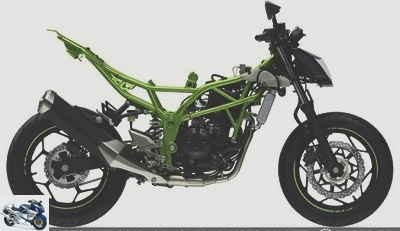
"Like any good Kawasaki engine", assure the Akashi Greens, this engine "delivers smooth and adequate power in the low and mid-range, and striking power at the top." Based on the 250 cc of the Ninja SL (single cylinder not marketed in France, not to be confused with the twin of the 2007 Ninja 250), the 125 is however considered a new engine at Kawa.
The small mono adopts dimensions which have been proven on the eighth-liter segment: 58 mm bore for 47.2 mm stroke, or exactly the same as a certain Duke! 28mm intake body and 8-hole injector must participate in the playful character of the Kawa engine.
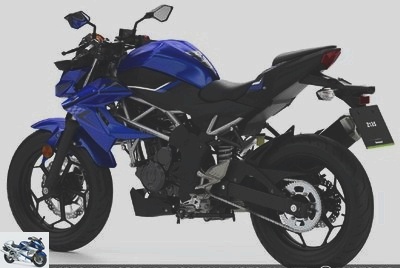
The aluminum cylinder – lighter than steel – is reinforced by an "ultra-hard" treatment which should promote heat transfer and lubrication of the piston, small but strong! A counter-balance driven by pinions is responsible for improving the balance of the assembly – better idling – and limiting vibrations.
According to the manufacturer, the airbox is large enough to fill the small mill, but compact enough to ensure the motorcycle (Z and ZX motorcycles …) a fine size. At the other end, the muffler consists of a 28.6mm diameter manifold and then a six-sided silencer.
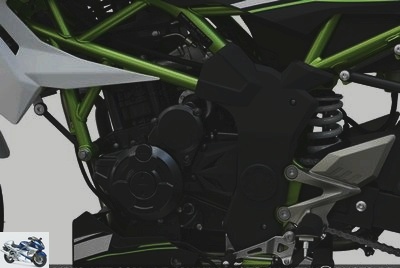
The engine is powered by an 11 liter tank, narrow and relatively high: the drivers of the Ninja on the road can thus lean on it to rest their wrists put to use by the half-handlebars. On the circuit too, pilots find a convenient point of support..
The six-speed gearbox is supposed to "offer a gear for every situation" … The stages are so good that Kawasaki did not consider it necessary to modify them according to its models: the sports car and the roadster receive the same gearbox, as well as the same final gear. The Z and the Ninja thus have the same accelerations, times and maximum speed (118 km / h counter).
Part-cycle
Like the last generation of "Zed" (650 and 900), so the sulphurous Ninja H2, the Z125 and Ninja 125 are equipped with a steel tube frame, each section of which has been "carefully selected. "reassures Kawasaki. The absence of a frame under the engine helps to limit the weight of the machine: 146 kg dry for the Z, 148 kg for the ZX.
At the front, the same 37 mm fork – not inverted, oh … – dipping at an angle of 23.1 ° on the roadster and 23.8 ° on the sports car, in order to distinguish, very slightly, the behavior of the two practically twin sisters. The socket is however identical (90 mm).
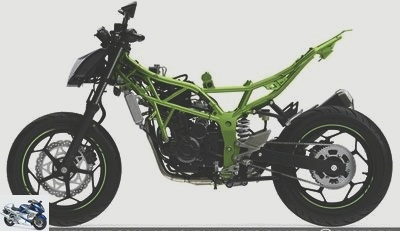
Second difference in terms of dimensions: the maximum steering angle is 35 ° on the Z125, against 30 ° on the Ninja 125. The wheelbase being strictly the same (1330 mm), the Z must be able to make a U-turn on 5 m of asphalt, against 5.8 m for the Ninja
At the rear, the two small Kawasaki receive a Uni Trak type suspension whose rods have the function of making the mono shock absorber work progressively: light on small bumps or hollows, more solid on large compressions.
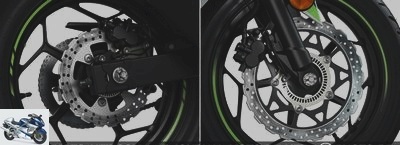
Unlike the previous 125 Kawa KLX and D-Tracker which received 19/16 inch and 14 "rims respectively, the Z and Ninja received 17" classics. They are shod with thin tires at the top: 100 / 80-17 in front, 130 / 70-17 in the back. As is often the case with Kawa, the brake discs are cut petal-like: a 2-piston caliper bites the 290 mm caliper at the front, another 2-piston also clamps the 220 mm caliper at the rear..
The third and final difference between Akashi’s two 2019 novelties in terms of dimensions: the roadster places its saddle at 815 mm in height, against 785 mm on the sports car. As an option, the Z offers a low saddle at 795 mm (162 €), while the Ninja can raise its to 805 mm (162 € also).
Electronics – instrumentation
No need for traction control or anti-skidding on these two very small engines. In terms of braking, on the other hand, the European Union imposes on the 125 cc, either combined braking or ABS. Like all its competitors, Kawa chose the second system.
"The compactness of the ABS unit allows it to be housed under the fuel tank", the Japanese say. ABS acts independently on both wheels. It cannot be deactivated, at the front or at the rear: apprentice stunters will not be able to learn about controlled skids.
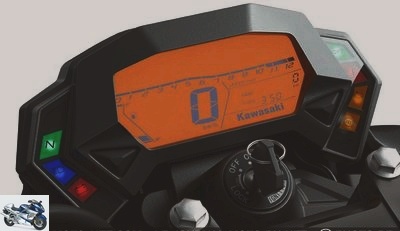
The Z125 and the Ninja 125 receive the same fully digital console showing engine speed, speed, total and two partial mileage, clock and fuel level. The essential therefore! The remaining autonomy or the average or instantaneous consumption is missing, as well as the gear indicator engaged.
Finally, a little subtlety regarding the instrumentation of these “Kawettes”: at night, the background of the Z screen appears white, that of the Ninja is nicely amber! Not enough to show off however, since the Duke offers a full color meter. Ditto for the thin key which is not coded, while the GSX-S125 goes so far as to offer a very practical "key-less" system.
Related articles
-
Kawasaki Z125 and Ninja 125 test: for generation Z or ZX-R bikers ? Unveiled in September, the Z125 and Ninja 125 land in mid-December in dealerships….
-
Kawasaki Z125 and Ninja 125 test: for generation Z or ZX-R bikers ? Unveiled in September, the Z125 and Ninja 125 land in mid-December in dealerships….
-
Kawasaki Z125 and Ninja 125 test: for generation Z or ZX-R bikers ? Unveiled in September, the Z125 and Ninja 125 land in mid-December in dealerships….
-
Ninja 650 test: Kawasaki camouflages its road in sport In 2017 Kawasaki introduces a new Ninja! Not a pistarde just approved for the road, but the…
-
Ninja 650 test: Kawasaki camouflages its road in sport In 2017 Kawasaki introduces a new Ninja! Not a pistarde just approved for the road, but the…
-
Ninja H2 SX test: sporty road bike, in green and against everything ! Kawasaki has no shortage of air: three years after the launch of its Ninja H2 / R,…
-
Honda CBR 250 R comparison test against Kawasaki Ninja 250 R
Comparison test: Honda CBR 250 R against Kawasaki Ninja 250 R 250cc super athlete for beginners Content of Honda’s CBR 250 R and the Kawasaki Ninja 250 R…
-
Ninja H2 SX test: sporty road bike, in green and against everything ! Kawasaki has no shortage of air: three years after the launch of its Ninja H2 / R,…
-
Ninja 650 test: Kawasaki camouflages its road in sport In 2017 Kawasaki introduces a new Ninja ! Not a pistarde just approved for the road, but the…
-
Z900RS test: the new neo-retro Kawasaki Zed, zen and zealous Kawasaki is back in the neo-retro segment with a brand new motorcycle: the Z900RS! Site was…